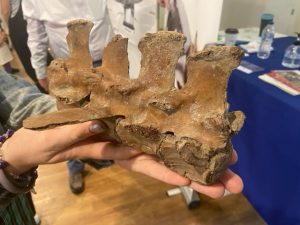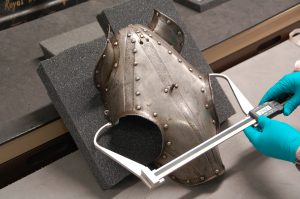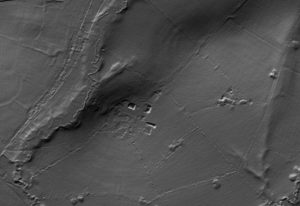Zooarchaeology
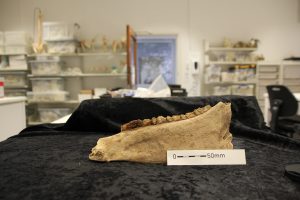
A lower jaw (mandible) of one of the horses from the Elverton Street assemblagey
A first research strand is the (re-)analysis of the bones of horses from archaeological excavations, across a sample of assemblages held by museums and archives. The use of advanced 3D geometric morphometrics (GMM) techniques is giving the work a scientific cutting edge (find out more here). We hope to identify characteristics in the skeletal remains that may relate to different in-life uses of horses, for example warfare. Some changes in bone morphology have genetic foundations related to breeding for particular capabilities, whilst others are plastic and caused by actual activities during life. Our zooarchaeological findings will be compared to genetic patterns seen through the analyses of the ‘Pegasus’ project.
Material Culture
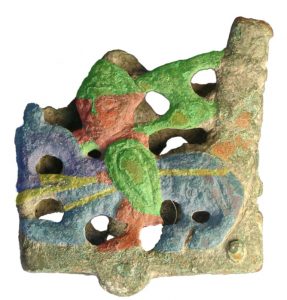
Interpretation of the design of a medieval sheath chape (PAS: SUSS-03FD90) (Image courtesy of the Portable Antiquities Scheme)
A second research strand is a comprehensive survey of surviving equine material culture, which comes in several different forms. The Portable Antiquities Scheme (PAS) produces huge quantities of new information annually on medieval horse gear (especially copper alloy objects found by metal detecting), which we are mapping and analysing alongside other published and unpublished materials, to refine the dating of these objects and to explore changes in their functional and decorative roles (learn more). Secondly, we are analysing items of horse armour (see here), which survive from the fifteenth century onwards in museums and other collections, to provide an index of warhorse morphology that will then be cross-compared against other sources including evidence from bones.
Landscapes and Documents
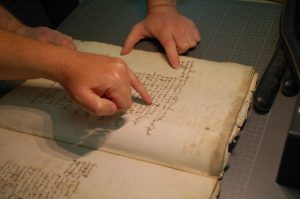
Deciphering medieval manuscripts
A third research strand is the archaeological study of horse breeding landscapes (especially studs), informed by analysis of published sources and unpublished documentary evidence (see our post on available sources here). Integrated analysis of new datasets has produced a fresh body of information about warhorses, their development, training, appearance, and by extension their military and social roles. It has long been recognised that horse studs were located within deer parks and as the location of these parks on the ground is often known, we have been able to pinpoint (and reconstruct) the horse breeding landscapes of the Middle Ages in a way that has not been attempted before.
Our Publications
O.H. Creighton, R. Liddiard, R., A.K. Outram, K.S. Kanne & C. Ameen eds. (2025) Medieval Warhorse: Equestrian Landscapes, Material Culture and Zooarchaeology in Britain AD 800-1550. Liverpool: Liverpool University Press.
https://www.liverpooluniversitypress.co.uk/doi/book/10.3828/9781836243359
G. Baker (2024). “Sitting on a Noble Horse as White as Snow”: The English Royal Horses at Agincourt, Journal of Medieval Military History 22, 172-229.
https://doi.org/10.1515/9781805433484-009
O.H. Creighton, A.K. Outram, and E. Wilkinson-Keys (2024). New light on the Warwick Shaffron: understanding horse and shaffron size through the collections of the Royal Armouries. Arms & Armour 21(1),1-24.
https://doi.org/10.1080/17416124.2024.2308447
Pryor, A. J., Ameen, C., Liddiard, R., Baker, G., Kanne, K. S., Milton, J. A., Standish, C.D., Hambach, B., Orlando, L., Chauvey, L., Schiavinato, S., Calvière-Tonasso, L. Tressières, G., Wagner, S., John Southon, J., Shapiro, B., Pipe, A., Oliver H. Creighton, O. & Outram, A. K. (2024). Isotopic biographies reveal horse rearing and trading networks in medieval London. Science Advances, 10(12), eadj5782.
https://www.science.org/doi/10.1126/sciadv.adj5782
R. Liddiard (2022). Wild, Wild Horses: Equine Landscapes of the Eleventh and Twelfth Centuries. In S. D. Church (Ed.), Anglo-Norman Studies: Proceedings of the Battle Conference 2021 (Vol. XLIV, pp. 35-53). Boydell & Brewer.
https://boydellandbrewer.com/9781783277131/anglo-norman-studies-xliv/
C. Ameen, H. Benkert, T. Fraser, R. Gordon, M. Holmes, W. Johnson, M. Lauritsen, M. Maltby, K. Rapp, T. Townend, G. P. Baker, L. M. Jones, C. Vo Van Qui, R. Webley, R. Liddiard, N. Sykes, O. H. Creighton, R. Thomas, A. K. Outram (2021). In search of the ‘great horse’: A zooarchaeological assessment of horses from England (AD 300–1650), Int J Osteoarchaeol, 1-11.
https://doi.org/10.1002/oa.3038
C. Ameen, G. P. Baker, H. Benkert, C. Vo Van Qui, R. Webley, R. Liddiard, A. K. Outram, O. H. Creighton (2021). Interdisciplinary approaches to the medieval warhorse, Cheiron 1, 100-119.
DOI: 10.22618/TP.Cheiron.20211.1.233005
https://trivent-publishing.eu/home/133-cheiron-vol-1issue-1.html
R. Webley (2020). Appliques en «B» : réexamen d’un objet médiéval énigmatique interprété comme une garniture de mors de bride, Cahiers LandArc 38, 1-12. https://ore.exeter.ac.uk/repository/43-Cahier_landarc_38.pdf
